8 Days 7 Nights
Daily Tour
50 people
___
| Semi Deluxe | ||
|---|---|---|
| ADULT | CHILD | INFANT |
| ₹44,999.00 | ₹0.00 | ₹0.00 |
| Deluxe | ||
| ADULT | CHILD | INFANT |
| ₹45,999.00 | ₹0.00 | ₹0.00 |
| Super Deluxe | ||
| ADULT | CHILD | INFANT |
| ₹50,999.00 | ₹0.00 | ₹0.00 |
| Luxury | ||
| ADULT | CHILD | INFANT |
| ₹89,999.00 | ₹0.00 | ₹0.00 |
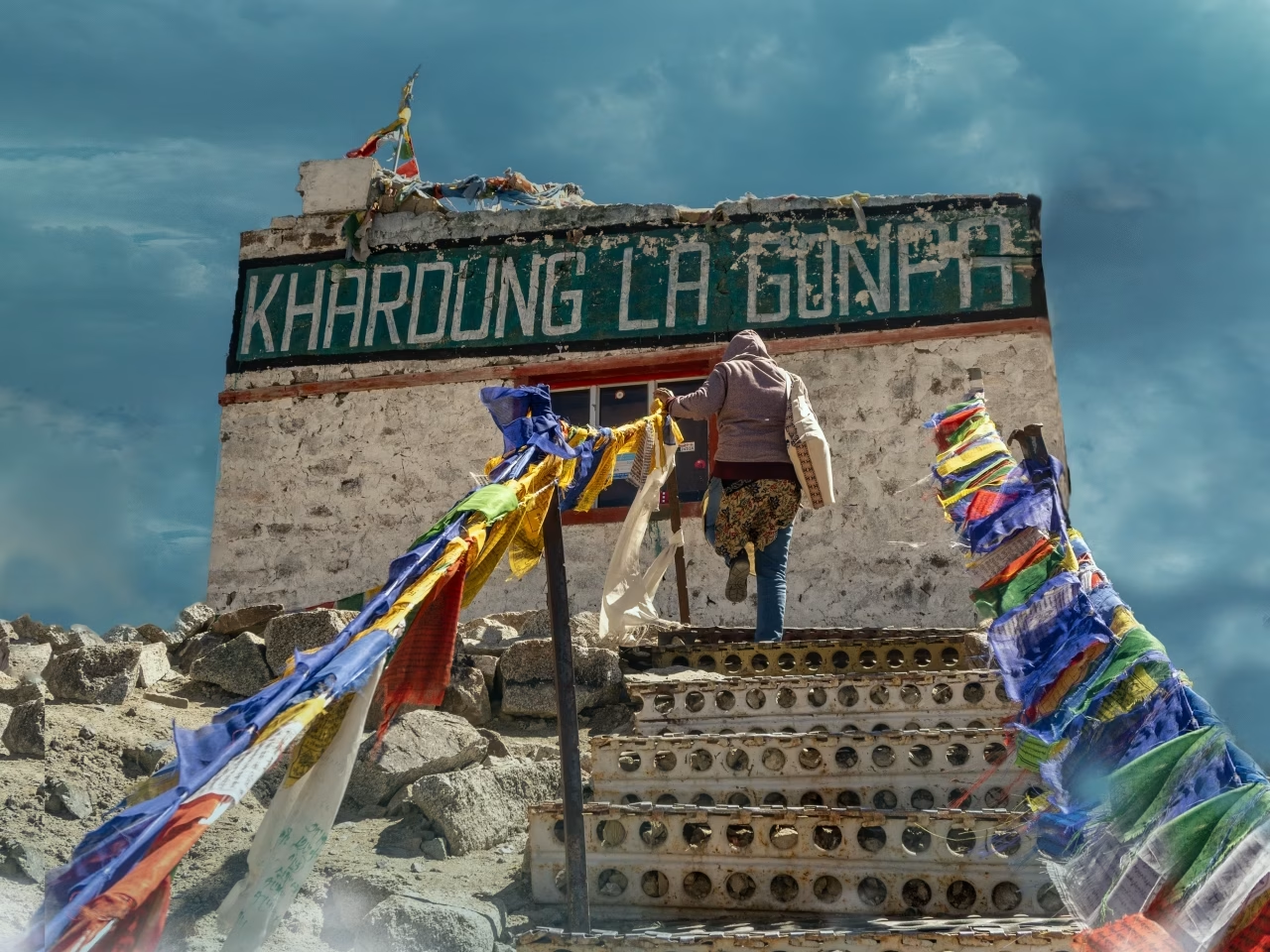
Altitude: 3500 m
We will pick you up and transfer you to the hotel upon your arrival at Leh Airport. After check-in, you can freshen up and rest for the day to acclimatise. In the evening, you can visit the area near your hotel on your own.
Meals: Dinner
Night: Stay at the hotel in Leh
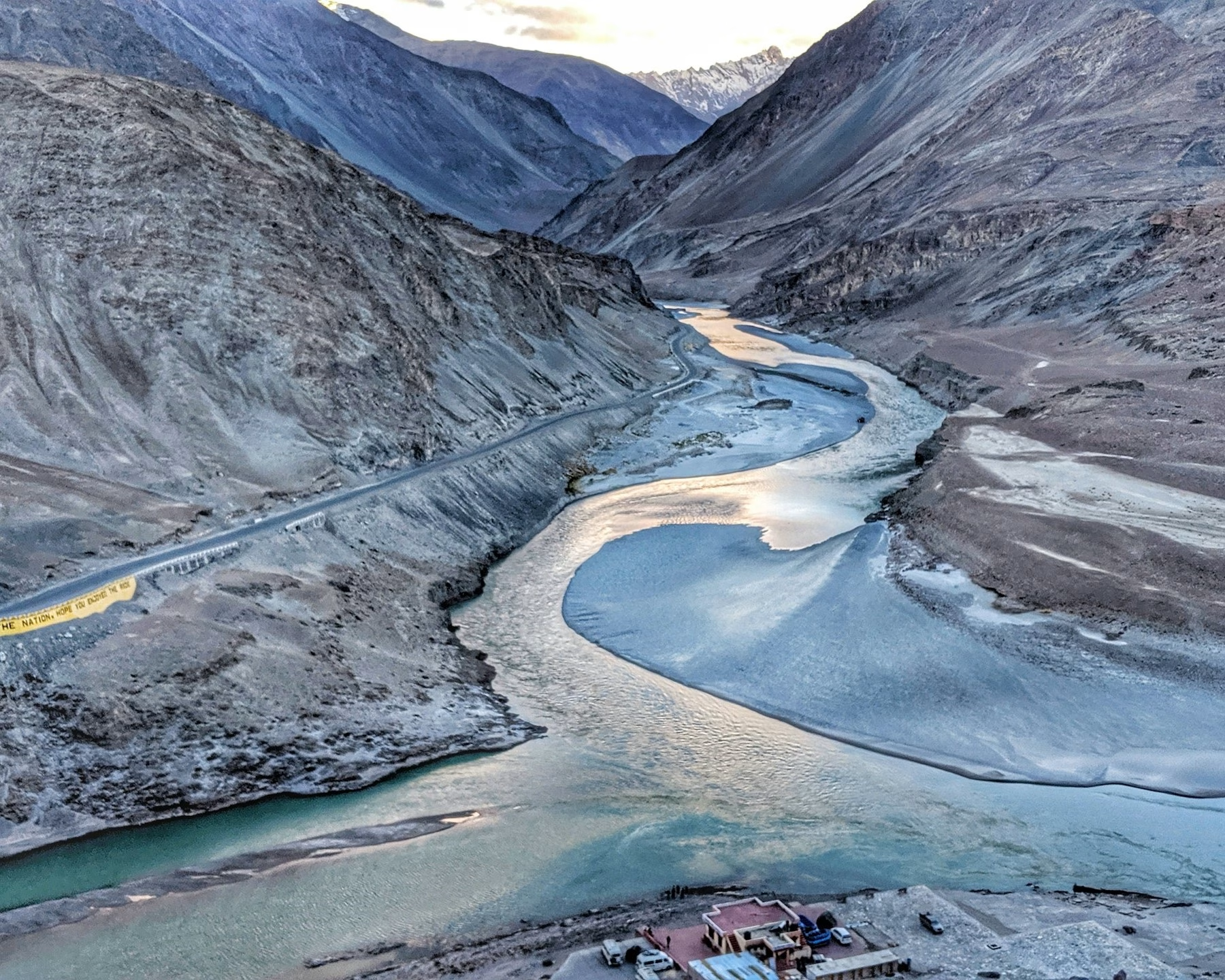
Dist: 70 km to 90 km | Altitude: 3300 m to 2600 m
After breakfast today, get ready for a local sightseeing tour. You will visit Leh Palace, Shanti Stupa, Hall of Fame War Memorial, Shey Monastery, Thiksey Monastery, Gurudwara Patthar Sahib, Magnetic Hill, and Rafting Point. In the evening, you will return to the hotel.
Meals: Dinner
Night: Stay at the hotel in Leh
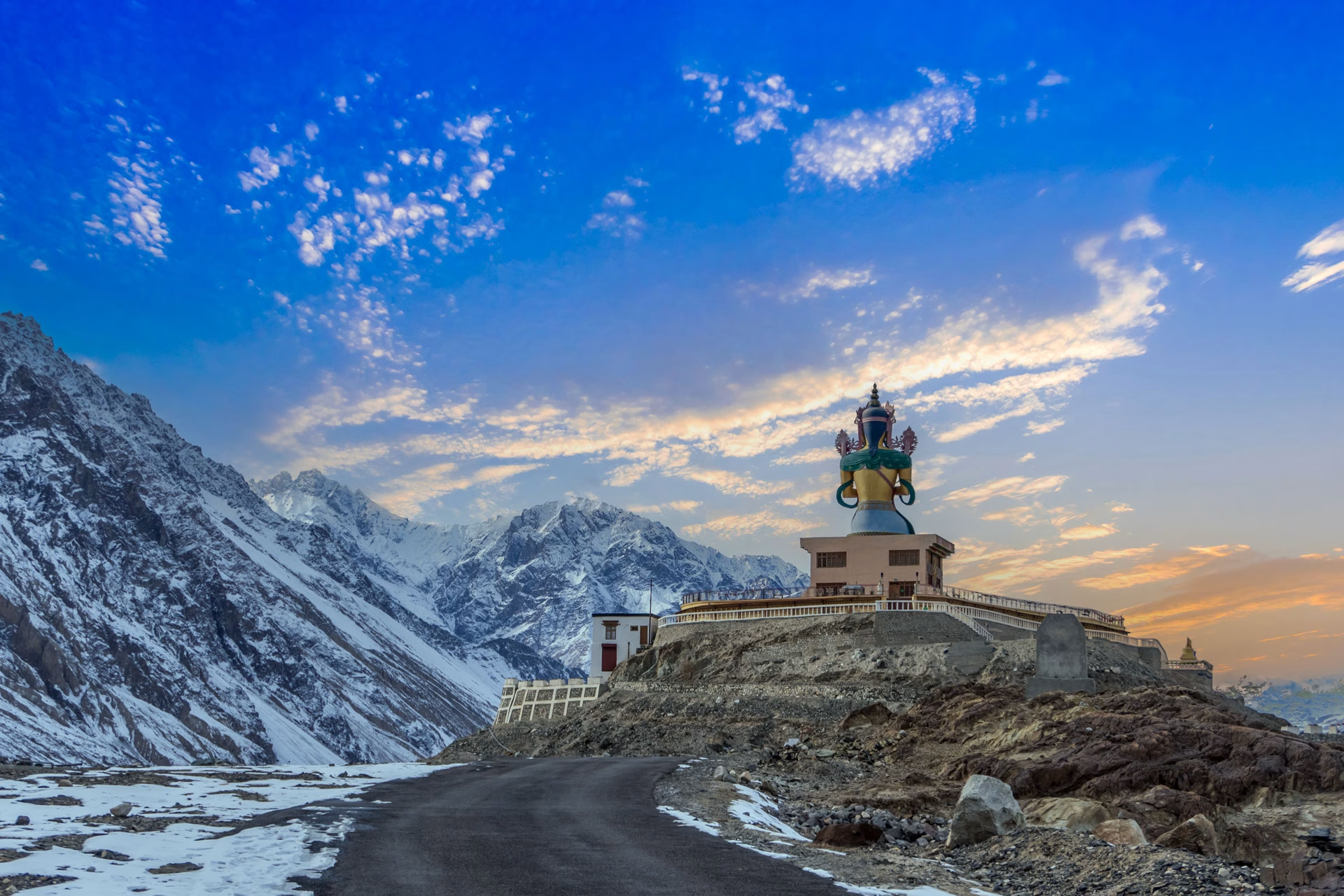
Dist: 160 km | Altitude: 3500 m to 5354 m
After enjoying a healthy breakfast, start your journey to Nubra Valley. You'll drive through Khardung La, the highest motorable pass, and visit Diskit Village and its monastery. Then, explore the dunes and enjoy a camel ride at Camel Ride Point. Finally, head to Hundar Village and check into your accommodation in Nubra Valley.
Meals: Breakfast, Dinner
Night: Stay at the hotel/homestay in Nubra Valley
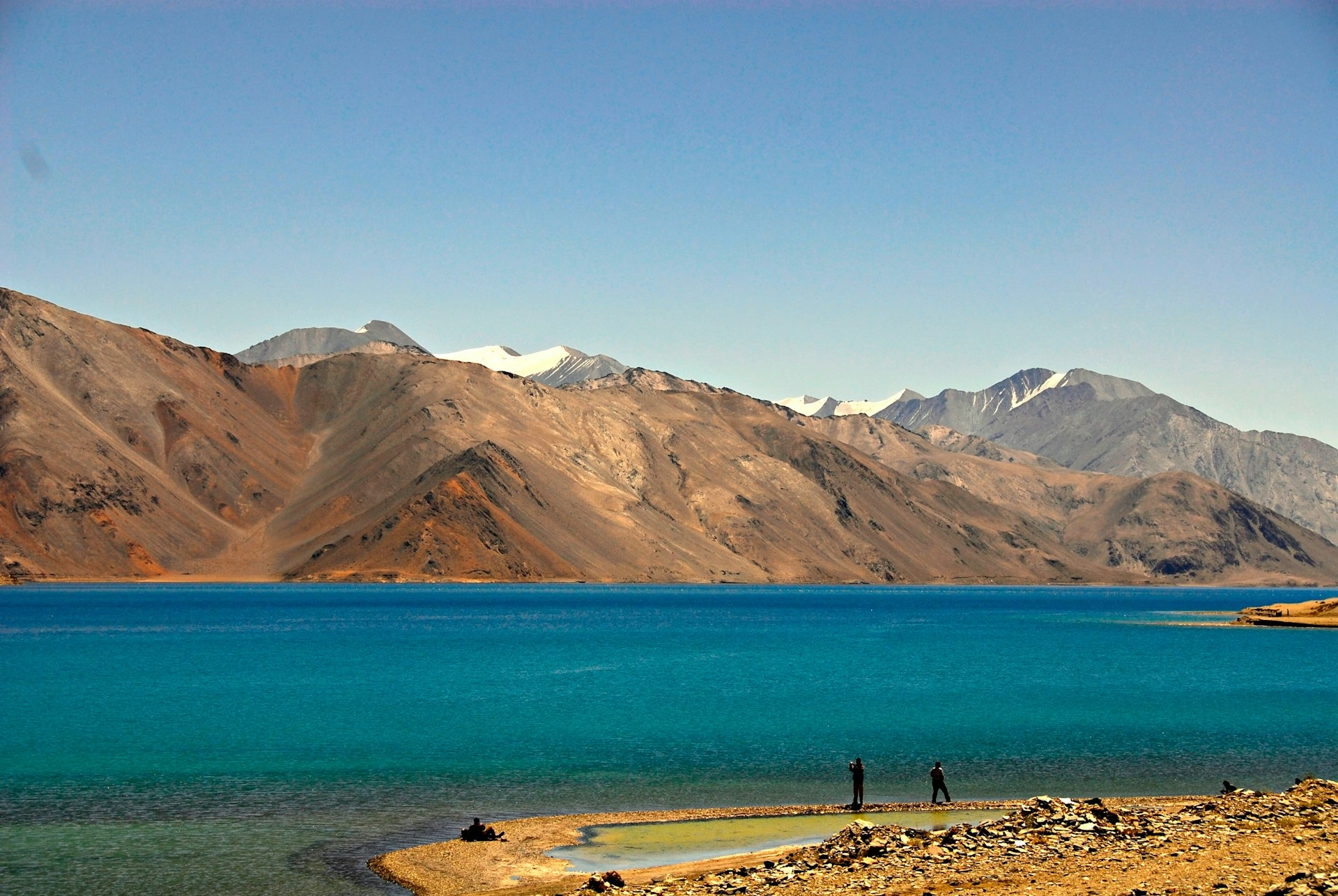
Dist: 200 km | Altitude: 3100 m to 4814 m
Today, wake up to a beautiful morning in the Karakoram ranges, preparing for an adventurous drive to a high-altitude saline Lake called Pangong Tso. From Nubra Valley to Pangong, you will visit Shayok Village, Durbuk Village, Tangsay Village, and Changla Pass. Later, you will check into your stay at Pangong.
Meals: Breakfast, Dinner
Night: Stay at the cottage/camp in Pangong
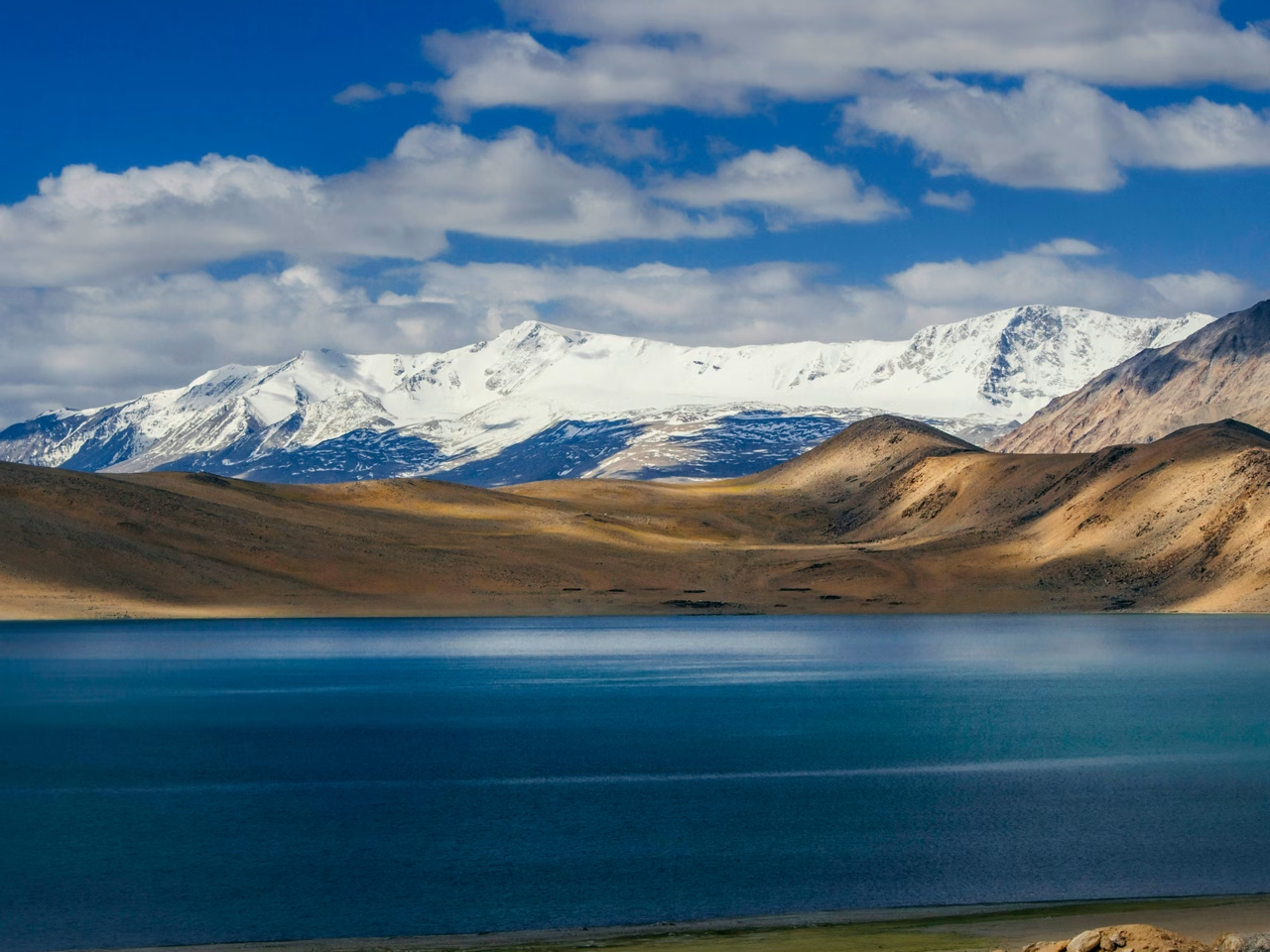
Dist: 217 km | Altitude: 3215 m to 4522 m
Wake up to the stunning view of Pangong Lake and enjoy a delicious breakfast. Then, head towards the route, passing through beautiful landscapes and witnessing stunning views of the majestic snow-covered mountains. You can also take a break in some small towns and villages. In the evening, return to the hotel.
Meals: Breakfast, Dinner
Night: Stay at a hotel in Leh
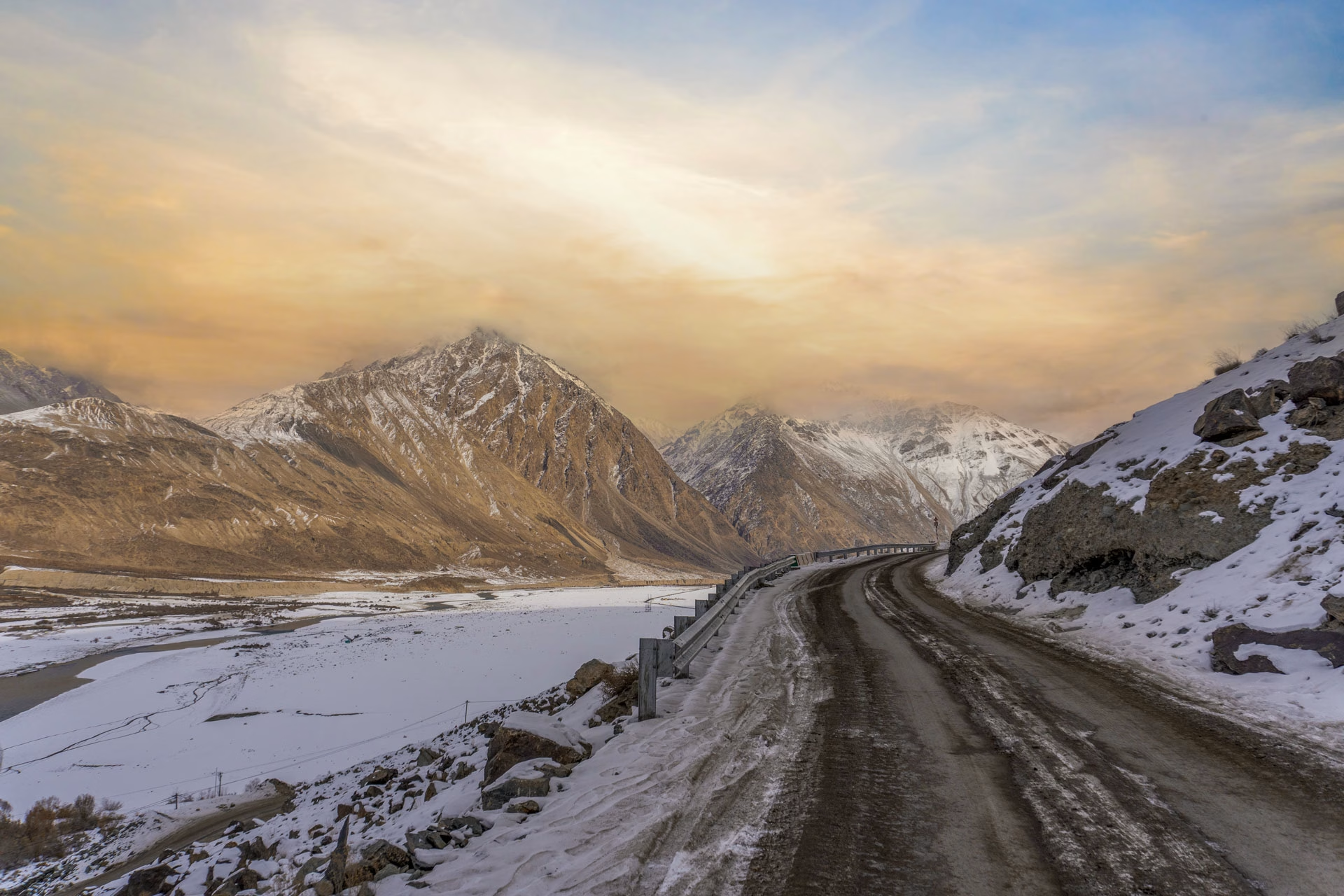
Dist: 220 km | Altitude: 4522 m to 3500 m
Today, after breakfast, you will visit beautiful destinations. You will visit Tso Kar Lake, Puga Hot Spring, Puga Village, Tanglangla Pass, Thiksey Monastery, Rancho School, and Shey Palace.
Meals: Breakfast, Dinner
Night: Stay at a hotel in Leh
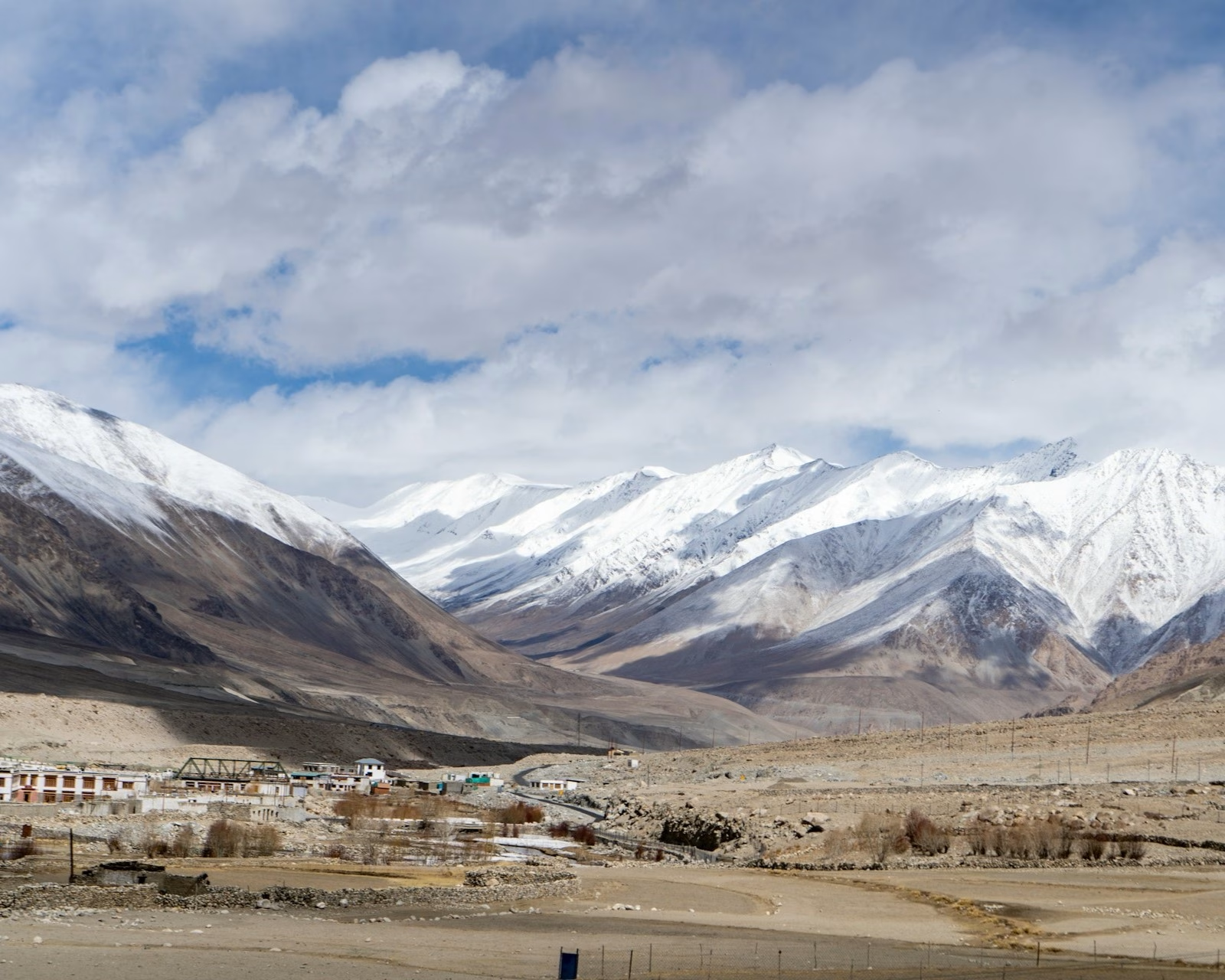
Dist: 210 km | Altitude: 4088 m to 2757 m
Today, you will head towards the beautiful Agas destination of Kargil. You will cover the Hall of Fame, Spituk Monastery, Gurudwara, Magnetic Hill, and Sangam Rafting Point at Leh.
Meals: Breakfast, Dinner
Night: Stay at a hotel in Kargil
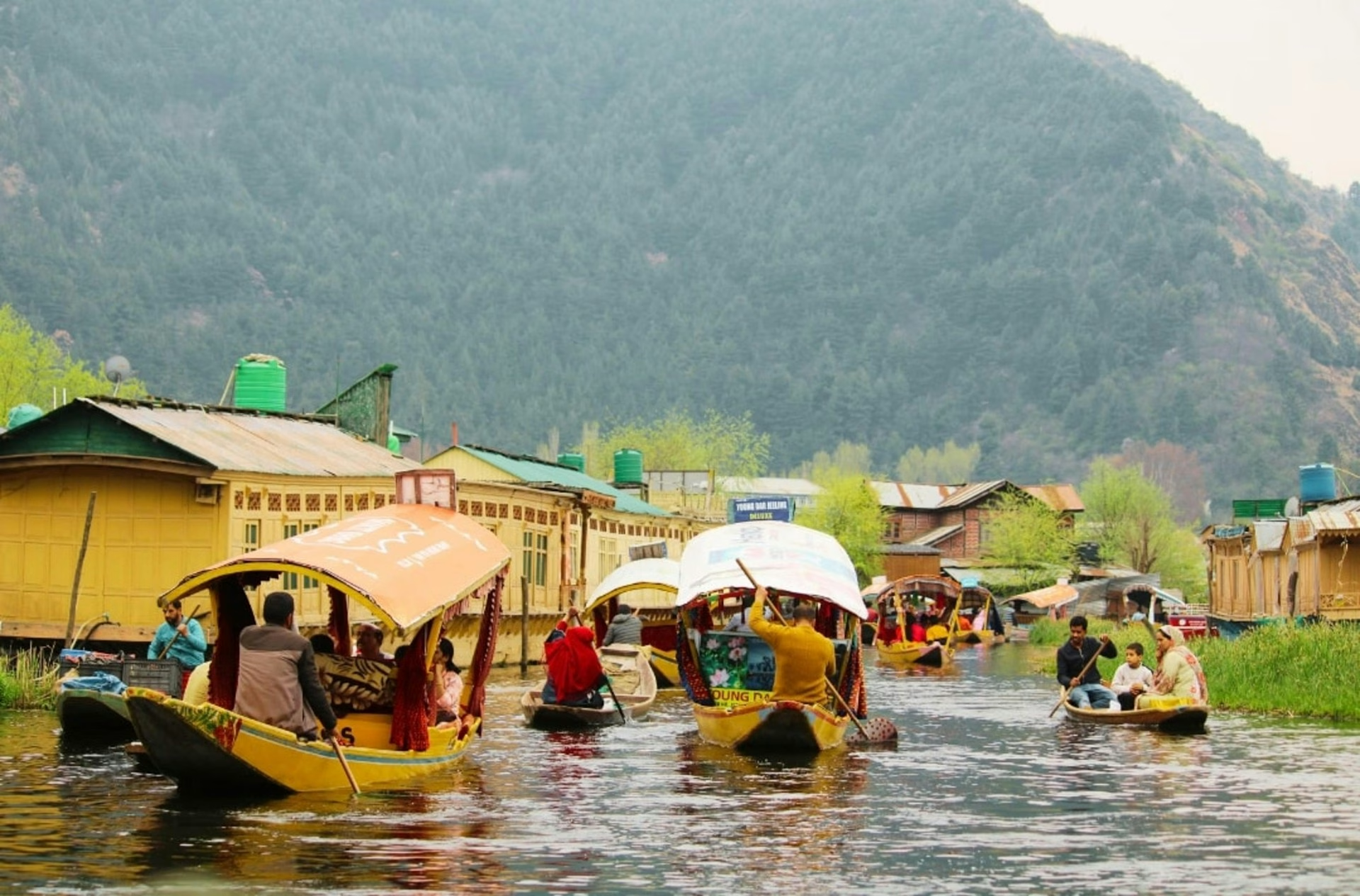
Dist: 201 km | Altitude: 3527 m to 1582 m
After breakfast, check out of the hotel and depart for Srinagar with countless memories of Leh’s beauty, serene landscapes, and warm hospitality, carrying unforgettable moments of your Himalayan adventure.
Meals: Breakfast
Night: Nil
| Location | Places to visit |
| Leh | Hall of fame War memorial, Shey Monastery, Thiksey Monastery, Shanti Stupa, Leh Palace, Leh Market, Gurudwara Patthar Sahib, Magnetic Hill, Rafting Point. |
| Nubra | Khardung La, Diskit Village, Diskit Monastery, Sand Dunes, Camel Ride Point, Hunder, Shyok River. |
| Lukung | Shayok, Durbuk, Tangsay Village, Pangong Lake, Chang la Pass. |
| Tso Moriri | Korzok monastery, a Buddhist monastery in Korzok village, the Tsomoriri viewpoint, the Kayger Tso Lake, the Tso Moriri wetland reserve, and the Tsokar Lake |
| Kargil | Kargil City Viewpoint, Mulbkesh Monastery, Munshi Aziz Bhat Museum, Rangdum Gompa, and Kargil War Memorial. |
Note:
Leh
| Semi Deluxe | Borgo Villa, Jeevanam Villa |
| Deluxe | Nature’s Land, Hotel Lalingkha, Hotel Bluestone, Mahey Retreat, Maple Ladakh |
| Super Deluxe | Himalayan Retreat Karzoo, Hotel Spa, Charu Palace, The Kaal |
Nubra
| Semi Deluxe | Nubra Boutique Camp, Royal Mount, Pika Camp, Weeping Willow Camp |
| Deluxe | Paramount Camp, Ladakh Elysium Camp, Urth Home Boutique |
| Super Deluxe | Paramount Super Deluxe, Urth Home Boutique |
Pangong
| Semi Deluxe | White Heaven Cottage, Mystic Mountain Cottage, Native Retreat Cottage |
| Deluxe | Zamta View Point, Native Retreat Cottage, Star Sherathon Cottage |
| Super Deluxe | Snowpine Wooden Cottage, Gongma Residency, Polarise Cottage |
Tso Moriri
| Semi Deluxe | Tsomoriri Guest House, Tsomoriri Inn |
| Deluxe | Tsomoriri Guest House, Tsomoriri Inn, Tsomoriri Guest House, Dorjay Khangsar, Yumchen Cottage |
| Super Deluxe | Grand Dolphine, Wisdom House |
Kargil
| Semi Deluxe | Jan Palace, Hotel Jazeera Hangout, Hotel Greenland |
| Deluxe | Hotel Rangyul, Hotel Siachen |
| Super Deluxe | Royal Gasho, Zojila Residency |
We understand that plans can change, but the booking amount is non-refundable due to the costs we incur in preparing for your tour or activity. If you wish to reschedule for a different date, we'll adjust it to the same package, providing you with the necessary flexibility.
If you have paid the total amount but cancelled the package. You will be provided with a refund, as mentioned below:
Tours or activities may be cancelled due to unforeseen events beyond our control, such as weather conditions like heavy rain or storms, or government restrictions like sudden closures of specific areas. In such a scenario, we will provide an alternate tour or activity. However, no refunds will be provided.
Leh is a district located in the union territory of Ladakh, India, and serves as the starting point for the Ladakh Nubra Pangong Tso Moriri Kargil Tour, one of the most scenic Himalayan travel circuits.. Pakistan borders the district to the west, Tibet to the east, the Kashmir Valley to the south, and the Zanskar Range to the north. The capital of the district is Leh, which is also the largest city in the region. Known for its spectacular mountain scenery and rich cultural heritage, Leh attracts travellers exploring the Ladakh Nubra Pangong Tso Moriri Kargil Tour. The district has several Tibetan Buddhist monasteries, including Hemis, Thiksey, Shey, and Stok. The area also contains several historical forts, including Leh Palace and Namgyal Tsemo. The region’s economy primarily relies on tourism, agriculture, and handicrafts. The main crops grown in the Leh district are barley, wheat, peas, and potatoes. The region is also home to traditional handicrafts, such as carpets, shawls, and jewellery. Leh is a popular destination for trekking, mountaineering, and other outdoor activities. The area is known for its breathtaking views of the Himalayas and the surrounding valleys. It is also home to wildlife, including snow leopards, ibex, and blue sheep. Leh is an important centre of Tibetan Buddhism and has become an increasingly popular destination for spiritual seekers in recent years. The district has several critical Buddhist sites, including the 11th-century Lamayuru Monastery and the Shey Palace.
Kargil:
Kargil is a historic town in the Kargil District of Ladakh, India, and a key destination on the Ladakh Nubra Pangong Tso Moriri Kargil Tour itinerary. The city is 60 km from the Line of Control, the border between India and Pakistan. Kargil is situated on the Kargil-Leh highway and is the second-largest town in Ladakh after Leh. Kargil is the gateway to Ladakh and the Zanskar Valley. Kargil has a population of around 30,000 people, most of whom are Shia Muslims. Kargil was once a major trading centre on the Silk Road. Kargil is known for its ancient fort, mosques, and stunning Himalayan landscape, making it an essential stop for anyone taking the Ladakh Nubra Pangong Tso Moriri Kargil Tour. Kargil is also known for its cold desert climate and breathtaking views of the peaks of the Himalayas. Kargil is the home of the Kargil War, which occurred in 1999. The conflict between India and Pakistan. The war resulted in the loss of life on both sides and the displacement of thousands of people from the region. The conflict also caused significant economic and environmental damage to Kargil and the surrounding area.
Nubra Valley:
Nubra Valley, a highlight of the Ladakh Nubra Pangong Tso Moriri Kargil Tour, is a high-altitude valley nestled in the Ladakh Himalayas. It is situated between the Ladakh and Karakoram mountain ranges. The valley is divided by the Shyok River into two parts: the Nubra and the Shyok Valleys. Famous for its double-humped Bactrian camels and surreal desert landscapes, Nubra Valley enchants travellers on the Ladakh Nubra Pangong Tso Moriri Kargil Tour. The valley has several villages, including Diskit, Hundar, Sumur, Turtuk, and Panamik. It is also known for its hot springs, which are believed to have healing properties. The region is also home to various flora and fauna, including snow leopards, ibex, wild yaks, marmots, and Himalayan blue sheep. Nubra Valley is accessible from the town of Leh, which is the headquarters of the Ladakh Autonomous Hill Development Council.
Pangong Tso:
The stunning Pangong Tso Lake, featured prominently in the Ladakh Nubra Pangong Tso Moriri Kargil Tour, lies on the border between India and China. It is located at an altitude of 4,350 m (14,270 ft) and spans an area of about 600 km2 (232 sq mi). The lake is 5 km (3.2 mi) wide at its broadest point. Approximately two-thirds of the lake lies in China, while the remaining one-third lies in India. The lake’s blue-green waters and rolling hills make Pangong Tso a must-visit stop on any Ladakh Nubra Pangong Tso Moriri Kargil Tour or Ladakh travel package. It is also known for its rich biodiversity. Pangong Tso is also an essential source of fresh water for the local villagers, who rely on it for drinking and irrigation. The lake is also home to various fish species, including mahseer and snow trout. The lake freezes completely during winter, making it very difficult to traverse. During the summer months, the lake is often visited by a variety of wildlife, including kiangs, Himalayan marmots, and wild asses.
Tso Moriri:
A crown jewel of the Ladakh Nubra Pangong Tso Moriri Kargil Tour, Tso Moriri is a serene high-altitude lake in the Changthang region of Ladakh.. It is situated at an altitude of 4,521 m (14,836 ft) and is about 24 km (15 mi) long. It is the largest of the high-altitude lakes entirely within India, and it is a popular destination for trekking, camping and wildlife watching. Many wildlife species are in the area, including snow leopards, Tibetan wolves, marmots, kiangs and migratory birds. The lake is also an essential habitat for the endangered black-necked crane. The lake is sacred to the Ladakhis, and several monasteries surround it, offering a peaceful experience for travellers on the Ladakh Nubra Pangong Tso Moriri Kargil Tour. The most important is the Korzok Monastery on the lake’s western shore. The lake is also a popular destination for tourists and pilgrims. The Tso Moriri lake is also a Ramsar site, a wetland of international importance.
How to reach
Places to visit during Ladakh Nubra Pangong Tso Moriri Kargil Tour
The Hall of Fame War Memorial:
The Hall of Fame in Leh, India, is a museum dedicated to the heroes of the Indian Army’s regional operations. Located at the Hall of Fame base is the Siachen Glacier. The museum houses artefacts, photographs, personal belongings, and documents of the brave soldiers who have served in the region. It also displays weapons and equipment used by the Indian Army. It also has a library that houses books, magazines, and journals related to the Indian Army. It is a place of respect and honour for the soldiers who have sacrificed their lives for the country. The museum also memorialises those who have lost their lives in the region. The Hall of Fame is open to the public and is a popular tourist destination. It is located in the heart of Leh and is easily accessible. The museum is maintained and managed by the Indian Army.
Shey Monastery:
The Shey Monastery is 15 kilometres south of Leh in Ladakh, India. It is a Buddhist monastery of the Drukpa Lineage and was once the home of the royal family of Ladakh. It was founded by the king of Ladakh, Deldan Namgyal, in the early 17th century. The monastery is situated atop a hill. The monastery is home to a giant statue of Shakyamuni Buddha, made of copper and gilded in gold. It is believed to be the most massive statue in Ladakh, standing at more than 15 meters in height. The monastery also houses several ancient murals, sculptures and frescoes. These are said to date back to the time of the former king and depict scenes from the life of the Buddha. The monastery complex also includes a temple, a library, and a meditation hall. The monastery is open to visitors, and guided tours are available. It is also possible to stay at the monastery, as it has rented rooms.
Thiksey Monastery:
The Thiksey Monastery in Leh is one of Ladakh’s largest and most impressive Gelugpa monasteries. It is situated on top of a hill and overlooks the Indus Valley. The monastery is about 19 km east of Leh and is a 12-story complex resembling a small village. It belongs to the Gelugpa order and is a branch of the Yellow Hat Sect of Tibetan Buddhism. It has several temples, a prayer wheel, a library, and a large prayer hall. The most impressive feature of the monastery is a 14-meter-high statue of the Maitreya Buddha. The monastery is known for its traditional art, murals, and frescoes. The monastery is also home to several festivals and events throughout the year, such as Losar and the Thiksey festival. Monks perform traditional dances during these events, while visitors can enjoy traditional music and participate in religious ceremonies. Visitors can witness the monks chanting prayers every morning and evening in the monastery’s main prayer hall. Visitors can also purchase souvenirs from the monastery’s shop, such as prayer flags, incense, and other religious items.
Shanti Stupa:
The Shanti Stupa is a Buddhist white-domed stupa (a hemispherical structure containing relics, typically the remains of Buddha) located in Leh, India. It was built by the Japanese Buddhist organisation, the Japanese for World Peace. The stupa was completed in 1991 and is situated on a hilltop of the Ladakh valley. The stupa is a two-storey structure with a white-domed stupa on the top and a temple on the lower level. The temple houses a statue of Buddha and four statues of Bodhisattvas. The main stupa is carved with the images of the Buddha and his disciples. The stupa is surrounded by four statues of the Buddha in the four cardinal directions, symbolising the spread of Buddhism. The Shanti Stupa is open daily to visitors and is a popular tourist destination in Leh. Visitors can climb the stairs to the stupa or take the elevator, and there is an audio-visual presentation that explains the history of the stupa. There are also meditation and prayer sessions held at the stupa. The stupa is a popular pilgrimage site for Buddhists from around the world and is a symbol of peace, harmony, and harmony between people of all faiths.
The Leh Palace:
The Leh Palace is an ancient palace with nine stories in the Ladakh region of India. It was built in the 1600s by King Sengge Namgyal, the ruler of the Namgyal dynasty. It is also one of India’s few surviving examples of traditional Tibetan architecture. The palace was constructed over several decades and comprises some 900 rooms, though only a few are open to the public. The palace is three stories high and is decorated with murals and carvings. Visitors can find several Buddhist shrines and a small museum that houses artefacts from the region’s history. The palace was abandoned in the mid-19th century after being sacked by the Dogra forces of Maharaja Ranbir Singh. It has since been partially restored and is now a tourist destination. The Leh Palace has witnessed the region’s rich history and culture and is a reminder of the grandeur of the Dogra rulers. Its majestic structure and stunning views of the snow-capped mountains make it a must-visit tourist spot in Leh.
Leh Market:
In town, the primary market is the Main Bazaar. It is located near the old Leh Palace. The market is full of shops selling local handicrafts, traditional clothing and jewellery, souvenirs, food, and snacks. Many small stores also sell various items, including conventional Tibetan rugs, carpets, puppets, and more. Most shops here offer great bargains and a chance to interact with the locals. The Main Bazaar is a great place to shop for curiosities, as well as for everyday items. The market is also great for finding traditional Ladakhi and Tibetan items. The Leh Market has a long and rich history that dates back to the 15th century when the Ladakh region was a part of the Tibetan Empire. The market was a popular trading post with traders from Central Asia, Tibet, China, Kashmir, and Baltistan. Leh became a significant trading hub for wool, pashmina, salt, tea, and other goods. It continued to thrive and even expanded with the introduction of new goods such as silk, jewellery, and carpets.
Gurudwara Patthar Sahib:
Gurudwara Pathar Sahib is a historical Sikh shrine in the Ladakh region of India. It is situated 25 km east of Leh, the capital of Ladakh. The Gurudwara was built in 1517. The Gurudwara is located at an altitude of 13,400 feet and is accessible by a long winding road from Leh. The Gurudwara is built with huge stones, hence the name Pathar Sahib. It is believed that Guru Nanak Dev Ji meditated at this place for about three months. The Gurudwara is a popular pilgrimage destination for Sikhs and other travellers worldwide. The Gurudwara consists of two main sections: the Darbar Sahib and the Langar. The Darbar Sahib is the main prayer hall of the Gurudwara, where devotees come to offer their prayers. The Langar is a community kitchen that serves free meals to all visitors. The Gurudwara is open throughout the year, but it is best visited during the summer when the weather is pleasant. During the summer, thousands of devotees come to the Gurudwara to pay their respects and offer their prayers.
Magnetic Hill:
The Magnetic Hill in Leh is a natural phenomenon located on the Leh-Kargil-Baltik national highway, about 30 km from Leh. It is a hill with a strong magnetic field, which is said to have the power to pull cars uphill. The magnetic force is so strong that it can pull cars uphill at 20 km/h. The cars defy the law of gravity and go uphill instead of downhill. The Magnetic Hill is not the only such phenomenon in the region. Other hills with similar properties, such as the Pathar Sahib Hill and the Paranormal Hill in Himachal Pradesh. The local population believes the hill has spiritual powers and is considered sacred. People make offerings to the mountain through flowers, fruits, and lights. The exact reason behind the magnetic force is still unknown, but it is believed to be related to its magnetic properties. It is also thought that the hill has healing powers, and visitors often feel a sense of peace and tranquillity when they visit it.
Khrdung La:
Khardung La is a high-altitude pass situated in the Ladakh region. It is the highest motorable pass in the world at an elevation of 5,359 meters (17,582 ft) above sea level. The Siachen Glacier lies to the north of the pass, and the Zanskar Range lies to the south. The Khardung La is open from May to October yearly and is mainly used by Indian army convoys and tourists. It is home to various gompas, including the Shey Gompa, a 17th-century gompa situated on the top of a hill overlooking the valley. Other attractions in the area include the Chang La, which is a mountain pass located at an elevation of 5,359 meters (17,582 ft), the Thiksey Monastery, which is a 12th-century monastery located near the town of Leh, and the Nubra Valley, which is a high-altitude cold desert situated at an elevation of 3,000 metres (9,843 ft). Khardung La is also a popular destination for adventure sports and activities such as trekking, mountain biking, and jeep safaris. The region around the pass is home to a wide variety of wildlife, such as snow leopards, blue sheep, marmots, and the Himalayan ibex.
Diskit Village:
Diskit Village is a small village in the Nubra Valley of Leh district, India. It is the largest village in the Nubra Valley, home to around 2,000 people. It is the headquarters of the Nubra tehsil. Diskit is a perfect place to explore the beauty of the Nubra Valley, as it is in a picturesque environment surrounded by the majestic Karakoram Mountains. The village is known for its ancient monastery, Diskit Gompa, the region’s oldest and largest Buddhist monastery. The town has some beautiful attractions like the dunes of Hunder, the hot water springs of Panamik and the Shyok River. The village also has several unique cultural and religious activities, like the annual Dosmoche festival. The festival is celebrated every year in July or August and is attended by local and international tourists. During the festival, the villagers perform various rituals and dances, and tourists can also enjoy the grandeur of the festival. Diskit is also known for its unique cuisine. The local dishes are prepared with traditional ingredients and recipes handed down for generations. Some of the popular dishes include Pabok, Thukpa, and Skyu. Apart from its cultural attractions, the village is known for its natural beauty. It is the perfect place for a relaxing holiday, surrounded by breathtaking mountains and lush greenery. The town has many accommodation options, from luxury resorts to budget guest houses.
Diskit Monastery:
The Diskit Monastery, located in the Nubra Valley of Ladakh, India, is the area’s oldest and largest Buddhist monastery. It was founded in the 14th century and belongs to the Gelugpa School of Tibetan Buddhism. The monastery is home to many statues of Buddhist deities, including a 108-foot statue of Maitreya Buddha, the Future Buddha. The interior of the monastery is filled with religious paintings and murals. It also has a library with a collection of Tibetan texts. The Diskit Monastery is an important pilgrimage site for many Buddhists. Every year, a large festival is held honouring the monastery’s patron god, Padmasambhava, also known as Guru Rinpoche. This festival is celebrated with chanting, music, and dancing. Several smaller monasteries surround the Diskit Monastery. Several villages in the area are home to Ladakhi Buddhists. Visitors can enjoy trekking, camping, and other outdoor activities in the beautiful Nubra Valley. It is also a well-liked vacation spot, with many tourists drawn to the monastery’s majestic statues, historic manuscripts, and peaceful atmosphere.
Sand Dunes:
Let’s Dunes, the Nubra Valley, is a well-liked tourist destination in India. The dunes in the Ladakh region are over 100 kilometres long and up to 500 metres high. Golden sand moving over hills and valleys in the dunes creates a fantastic scene that is constantly changing. Leh’s dunes have a long history; there is proof of early human habitation in the region dating back to 5000 BC. According to local traditions, the dunes were treasured as a sign of fertility and abundance by the prehistoric civilisations who once called the area home. Due to its advantageous location on the Silk Road, the region used to be a significant centre for trade. Leh’s dunes have gained popularity as a tourist attraction in recent years. Visitors can engage in activities like camel rides, sandboarding, trekking, and stargazing while admiring the beautiful views of the nearby mountains and valleys provided by the dunes. The adjacent Nubra Nature Reserve is a great place to see the abundant wildlife in the area, including rare bird species and mammals. For anyone looking for a different kind of vacation experience, the dunes in Leh offer a stunning reminder of the region’s vast and exciting past.
Camel Ride Point:
Camel rides are available from various points in Leh, and the most popular point is the Camel Ride Point in the town of Leh. At the Camel Ride Point, visitors can take a leisurely ride through the desert, along the banks of the Indus River, and around the nearby villages. The ride takes about 1-2 hours, costing around INR 600-800. The camels are well-trained and friendly, and the guides are knowledgeable and experienced. The Camel Ride Point also offers camel safaris, sandboarding, and horse riding activities. The Camel Ride Point also has a great selection of souvenirs and local crafts to purchase. For those looking for a more adventurous experience, the Camel Ride Point also offers overnight camping trips. The Camel Ride Point is open daily from 9 AM to 7 PM. Visitors can book a ride in advance or just turn up on the spot.
Hunder:
The Hunder region is located in the eastern part of Ladakh. It is one of the country’s most remote and least populated regions. It is bordered by the Jammu and Kashmir districts of Kargil to the south, Leh to the east, and Dras to the west. The region is made up of several villages, each of which is encircled by several high mountain passes and passes. Hunder is a semi-arid region, with temperatures ranging from -20 degrees Celsius in winter to +35 degrees Celsius in summer. The region is rich in culture and has several critical Buddhist monasteries, which the region’s rulers built. The most famous of these is the Thikse Monastery, located in the village of Thikse. The Hunder region is also home to many spectacular lakes, such as the Pangong Lake, the Tsomoriri Lake, and the Tso Kar Lake. Hunder is famous for its adventure activities, such as trekking, mountain biking, and jeep safaris. It is also home to some of the most breathtaking mountain views in the world. The region is also known for its wildlife, including snow leopards, ibex, bharal, and various species of birds. The people of the region are mainly Buddhists and speak the Ladakhi language. The region also has multiple tribes, including the Changpas, nomadic shepherds. The region is known for its traditional handicrafts, such as carpets and unique jewellery. The valley is accessible by road from Leh, the capital of Ladakh, and can be reached by taking a two-hour drive from the city. The valley is also accessible by air; the nearest airport is Leh.
Shyok River:
The Shyok River is a tributary of the Indus River that originates in the Aksai Chin region in the disputed Kashmir region and flows through the Leh district of India’s northernmost state. The Shyok River is 545 kilometres (338 mi) long and is fed by the glaciers of the Karakoram Range and the Rimo Glacier. The Shyok River is a significant water source for the people of Leh and the surrounding area. It has several tributaries, including the Nubra River, which flows from the Siachen glacier. The Shyok River is a popular destination for rafting and kayaking, with many companies offering guided tours and other adventure activities. The Shyok River is also home to a wide variety of wildlife, including snow leopards, brown bears, Himalayan Tahrs and Himalayan Marmots. The Shyok River is a popular destination for birdwatching, with many species of waterfowl, songbirds, and raptors found in the area. The Shyok River is also home to various plant life, with grasslands, alpine meadows, pine, juniper, and birch forests. The banks of the Shyok River are extremely barren and lack vegetation, owing to the region’s frigid and dry climate.
Durbuk Village:
Durbuk is a small village located in the Leh district of Ladakh. The town is situated at an elevation of 3,500 meters above sea level. The village is home to around 500 people belonging to the Changpa tribe. The Changpas are a nomadic tribe that has lived in the region for centuries and are known for their unique culture and lifestyle. The primary source of livelihood for the people of Durbuk is rearing livestock. They also cultivate barley, wheat, and millet on the small patches of land they possess. The village also has some small stores where the locals buy daily necessities. The town has a few basic amenities such as electricity, water supply, and a small health centre. The villagers are very friendly and hospitable and are always willing to help tourists who visit the village. The village is also known for its proximity to the Pangong Tso, a spectacular glacial lake located at an elevation of 4,250 meters, and the Tso Moriri, another stunning high-altitude lake at an elevation of 4,500 meters.
Tangsay Village:
Tangsay Village is located in the Leh district, India. The village has a population of about 200, mostly Ladakhi Buddhists. Agriculture is the main occupation of the people here, with barley, potatoes, and apples being the main crops. The village has a few shops and small businesses, including a bakery. It is also home to several monasteries, including the Tangsay Monastery and the Tangsay Gompa. The village is accessible by road, although snow in winter often blocks the streets. The nearest airport is in Leh, which is about 30 km away. The village has also become a popular destination for trekkers who explore the area’s remote valleys and ancient monasteries. Several guesthouses are in the town, and homestays are also available. Tangtse is a beautiful, peaceful village with a unique and vibrant culture. It is a great place to visit for anyone looking to have an authentic experience of Ladakh.
Pangong Lake:
Pangong Lake is a beautiful high-altitude lake in the Himalayan mountain range in the union territory of Ladakh, India. It is the highest saltwater lake in the world, located at an altitude of 4,350 m (14,270 ft) above sea level. It is 134 km (83 mi) long. The lake is one of Ladakh’s most popular tourist attractions, known for its deep blue colour and serenity. The lake is surrounded by mountains, with the north and south banks of the lake forming the border between India and China. The lake freezes completely during winter, and it is not unusual to see a layer of ice floating on the lake even though the temperatures in Leh can be as high as 20 degrees Celsius in the summer months. The lake is home to a wide variety of species of birds and animals, including the rare snow leopard, wild ass, red fox and Himalayan marmots. The water of the lake is crystal clear and is a deep blue colour. The best time to visit the lake is from June to October when the weather is pleasant.
Chang La Pass:
Chang La is a high-altitude mountain pass in Ladakh that links the Changthang Plateau with the Indus Valley. The pass is 17,590 feet (5,360 m) above sea level. The pass is located on the road between Leh and Pangong Lake and is one of the region’s main attractions. The pass is named after the Changpa nomads who inhabit the area. It is also home to several Buddhist monasteries, including the famous Thiksey Monastery. The pass is known for its picturesque views of the mountains, valleys and lakes. The region is also home to wildlife, including the endangered snow leopard. The pass is open to motor vehicles from May to October when the weather is favourable. The pass can be treacherous in winter and is usually closed due to heavy snowfall. The road to the past is filled with stunning beauty and is the perfect place for photography and sightseeing. The Chang La Pass is also known for its spiritual significance and is home to the famous Chang La Baba Temple, dedicated to the Tibetan Buddhist saint Chang La Baba.
Tso Kar lake:
Tso Kar Lake is a high-altitude lake in India’s Rupshu Valley of the Changthang region. It lies in the Himalayan mountain range at an elevation of 4,595 meters (15,069 feet) and is approximately 135 km (84 mi) east of Leh. The lake is part of the Tso Kar Wetland System, a Ramsar site. Several small streams and spring runoff from the surrounding mountains feed the lake. A barren landscape surrounds the Tso Kar Lake and is home to several species of wildlife, including snow leopards, blue sheep, marmots, and wild asses. The lake is also famous among local nomads, who use it for grazing their yaks and livestock. The region around Tso Kar Lake is a high-altitude desert, and the lake is rarely visited by tourists, making it an ideal destination for those looking for a peaceful and tranquil getaway. The lake can be reached by road from Leh, or it can be reached by trekking from the nearby villages. The region also offers excellent opportunities for camping, as well as for taking part in activities such as bird-watching, fishing, and trekking.
Tso Moriri View Point:
Tso Moriri, or the Mountain Lake, is located in the Changthang region of Ladakh, India, at an altitude of 4,522 m (14,836 ft). It is a large and beautiful high-altitude lake surrounded by snow-clad mountains. The lake is about 28km long and up to 6km wide. Tso Moriri View Point is one of the most picturesque locations in Ladakh. It offers a 360-degree view of the lake and its surroundings. The viewpoint is on a ridge overlooking the lake and the surrounding mountain ranges. It is a popular spot for tourists and photographers to take in the stunning views and take photographs. The lake has been declared a wetland reserve home to various birds and wildlife. It is also a breeding ground for the bar-headed goose and the black-necked crane. These birds migrate to the lake during the summer months for breeding. There are several trekking trails in the area, and it is also possible to take a jeep safari to explore the surrounding areas. The area has several monasteries, a popular spot for spiritual seekers. Tso Moriri View Point is a fantastic spot to take in the beauty of the lake and its surrounding landscape.
Mulbekh Monastery:
Mulbekh Monastery is a Buddhist monastery located in the remote village of Mulbekh in the Kargil district of Leh, India. It is one of the region’s oldest and most important monasteries, founded in the 8th century by the great Indian sage Padmasambhava. The monastery is home to around 200 monks who follow the Karma Kagyu sect of Tibetan Buddhism. The monastery’s main attraction is the 9-meter-tall Maitreya Buddha statue, built in the 9th century. The statue is carved out of a single rock and is said to be the most giant rock-cut statue in the region. The statue is considered an essential symbol of the area and is visited by pilgrims worldwide. The monastery is surrounded by a wall with two main gompas (temples). The first is the main temple, which is dedicated to Padmasambhava and contains his statue. The second is the temple of the Maitreya Buddha, which is located outside the main temple and is dedicated to the Maitreya Buddha. The Mulbekh Monastery also houses several other artefacts, including an extensive collection of ancient scriptures, statues, paintings, and murals. The monastery is open to visitors throughout the year and offers a range of activities, such as meditation classes, lectures, and cultural events. The monastery is also home to several monastic institutions, including a Buddhist college and a library. The library contains an extensive collection of Buddhist texts and manuscripts.
Munshi Aziz Bhat Museum:
Munshi Aziz Bhat Museum is located in Kargil, Ladakh, India. It is a museum dedicated to the life and works of Munshi Aziz Bhat, a 19th-century Kashmiri poet and scholar. The museum was established in 2018 and is managed by the Academy of Art, Culture and Languages. It houses a collection of manuscripts, books, photographs, paintings and artefacts related to Munshi Aziz Bhat’s life and works. The museum also displays documents related to the history of Kargil and its people. It is an essential source of knowledge and information about the region’s cultural heritage. Munshi Aziz Bhat Museum is located in Kargil, the region’s first museum dedicated to the memory of the renowned 18th-century poet and scholar Munshi Aziz Bhat. The museum contains a variety of artefacts, including manuscripts, books, paintings, manuscripts, and other items related to the poet. It also includes an exhibition of traditional arts and crafts from the region and a library with an extensive collection of books.
Kargil War Memorial:
The Kargil War Memorial is located in Kargil (Dras), in the Kargil district of Ladakh, India. It was built by the Indian Army and is located atop Tololing Hill, one of the major battlegrounds during the war. The Memorial was inaugurated on 26 July 2003 by the then PM of India, Mr Atal Bihari Vajpayee. It is spread over four acres of land and consists of a wall of remembrance, an eternal flame, a museum, and a gallery.
The monuments are situated at 10,000 feet and overlook the Srinagar-Leh Highway and Kargil town. The wall of remembrance is inscribed with the names of more than 500 soldiers who lost their lives during the war. The eternal flame is lit to symbolise the spirit of the brave soldiers and their indomitable courage. The museum contains various artefacts related to the war, including weapons, uniforms, and belongings of the fallen soldiers. The gallery houses photographs of the martyrs and the Indian Army personnel who fought in the war. The Memorial is visited by hundreds of people each year, including soldiers, veterans, and tourists. The Memorial is a symbol of national pride and the courage of the Indian Army. It symbolises the courage, bravery and sacrifice of the Indian armed forces in defending the country’s border.
Leh, the administrative centre of Ladakh, lies at 11,500 feet in the Himalayas. It is a crucial transport hub connected to Manali, Srinagar, and Delhi. Notable landmarks include Leh Palace, Shanti Stupa, Jama Masjid, and Hemis Monastery, the largest in Ladakh. The city hosts the Hemis Festival (June) and the Ladakh Festival (August).
Kargil, a town in Ladakh at 2,674 meters, lies on the Indus River, 205 km from Srinagar. It is the district headquarters and a stopover for Zanskar and Drass tourists. Surrounded by Himalayan peaks, it features Buddhist monasteries like Mulbekh Gompa. Kargil has a semi-arid climate, with warm summers (28°C) and cold winters (-10°C).
Nubra Valley, a high-altitude cold desert at 10,000 feet in Ladakh, lies between the Karakoram and Ladakh ranges. Known for its breathtaking landscapes, it features Buddhist monasteries, ancient Silk Route sites, and diverse wildlife like the snow leopard and Tibetan wolf. The valley is ideal for trekking, mountaineering, wildlife viewing, and cultural exploration.
Tso Moriri, a pristine lake in Ladakh, lies 240 km east of Leh on the Changthang Plateau. Surrounded by snow-capped mountains, it is part of the Changthang Wildlife Sanctuary, home to rare wildlife and migratory birds like bar-headed geese and black-necked cranes. The lake's crystal-clear waters are fed by springs, snowmelt, and rain. Accessible by road from Leh, it offers stunning high-altitude desert scenery.
Pangong Tso, a high-altitude saline lake at 14,000 feet, spans 134 km between India and Tibet. Known for its vivid blue-green hues, five rivers feed it and support diverse flora, fauna, and migratory birds like bar-headed geese and black-necked cranes. Accessible via a three-hour drive from Leh, it is a crucial tourist attraction in Ladakh.
The Ladakh Nubra Pangong Tso Moriri Kargil Tour typically takes 8-9 days. Travel from Leh to Nubra Valley via Khardung La Pass. It includes exploring Nubra Valley and visiting the famous dunes, as well as Pangong Lake and its surrounding areas.
The distance between Leh and Nubra Valley is about 120 kilometres. The journey by road takes about 5-6 hours, depending on the traffic and weather conditions. The route to Nubra Valley from Leh is a picturesque drive, passing through the Khardung La Pass, the world's highest motorable pass at 18,380 ft.
Leh is a beautiful hill station in India. It is situated at an altitude of 11,510 feet above sea level.
By Air: The most convenient and fastest way to reach Leh is by air. Leh Kushok Bakula Rimpochee Airport is the only airport serving the town. It connects major cities such as Delhi, Srinagar, Jammu, Mumbai, Bangalore, and Chandigarh. The flight duration from Delhi to Leh is approximately 2 hours.
By Road: The road to Leh is long and winding. It is almost 600 km from Srinagar to Leh. The route passes through the famous Zojila Pass, located at 11,578 feet. The journey from Srinagar to Leh takes around 12-14 hours. The journey from Manali to Leh is extended and takes 18-20 hours.
By Train: Jammu Tawi is the nearest Railway Station, about 600-700 km from Leh. From Jammu Tawi, one must take a bus or hire a taxi to reach Leh. The journey takes about 14-15 hours.
Leh is located in the Ladakh region and is approximately 934 km away from Delhi. The drive from Delhi to Leh takes approximately 20-22 hours. The route that is usually taken is Chandigarh-Kullu-Manali-Rohtang Pass-Sarchu-Leh. It is a long and arduous journey, but the scenic beauty that one experiences is worth the effort.
Nubra Valley is located in Ladakh, India. You must first reach Leh, Ladakh's capital city to reach it. Leh is well connected to major cities in India by air, road, and rail.
By Air: The nearest airport to Nubra Valley is the Kushok Bakula Rimpochee Airport in Leh. There are regular flights to Leh from Delhi, Srinagar, Jammu, Chandigarh, Mumbai, Kolkata, and other major cities in India. You can hire a taxicab or private cab from the airport to reach Nubra Valley, about 150 km away.
By Road: Leh is well connected to Manali, Srinagar, and other cities in Jammu and Kashmir. The journey from Leh to Nubra Valley is roughly 3-4 hours.
By Train: Jammu Tawi Railway Station is the nearest railway station to Nubra Valley. You can take the train from Delhi or other major cities to Jammu Tawi. From Station, you can take a taxi to get to Leh, which is about 700 km away. You can taxi from Leh to Nubra Valley, which is about 150 km away.
The language spoken in Leh is Ladakhi, a Tibetan-Burmese language belonging to the Sino-Tibetan language family. It is spoken by around 200,000 people, primarily in India and parts of Tibet and northern Pakistan. Ladakhi is closely related to the Balti language of Baltistan, which is spoken in parts of Pakistan. It is also closely related to Nepal's Mustang, Dolpa, and Manang dialects.
Leh, a city in the Indian Union Territory of Ladakh, is 3524 meters (11,562 feet) above sea level. Leh is the capital of Ladakh and lies at the junction of the Indus and Zanskar rivers.
It is difficult to say which is better since Pangong and Nubra Valley offer spectacular landscapes and activities. It is known for its vast expanse of blue water and its stunning views of the mountains. The lake is home to various migratory birds, and visitors can also spot wild animals such as marmots and yaks. There are several camping and trekking activities available in the area. It is a high-altitude cold desert valley between the Karakoram and Ladakh mountain ranges. Nubra is known for its lush green valleys, snow-capped peaks, hot springs, dunes, and the Bactrian camels that can be seen in the area. The area has numerous trekking camping opportunities, as well as activities such as camel safaris, river rafting, and mountain biking. In conclusion, both Pangong and Nubra Valley offer spectacular landscapes and activities. It ultimately comes down to personal preference and which activities you would like to do.
Nubra Valley is a cold desert in Ladakh. It is one of the most beautiful and remote regions of the country. It is located north of the main Himalayan range and surrounded by snow-capped peaks and the Karakoram mountain range. The valley is known for its stunning scenery, Buddhist monasteries, and the two rivers, the Shyok and the Nubra, which flow through it. Other valley highlights include the dunes, double-humped Bactrian camels, and friendly locals. It is also home to some of India's most spectacular trekking routes.
Pangong Lake is frozen from December to March. The lake is completely frozen during the coldest months of January and February. The ice remains until the end of March when the temperatures rise again.
Yes, in India's northernmost state, Nubra Valley experiences snowfall during the winter months. The higher altitudes experience more snow than the lower altitudes. The snowfall usually begins in October and lasts until April, with the heaviest snowfall seen in January and February.
The Nubra Valley is home to the Siachen Glacier, the world's second-longest glacier outside the polar regions. It is located near the Line of Control between India and Pakistan and is one of the most heavily militarised regions in the world. The Siachen Glacier is known for its high altitude and extreme weather, making it one of the most challenging glaciers to traverse.
Things to do during Ladakh Nubra Pangong Tso Moriri Kargil Tour.
Explore the beauty of Leh: Visit Shanti Stupa and Leh Palace.
Visit Nubra Valley: Take a camel safari in the dunes, visit the Diskit and Hunder monasteries and explore the picturesque landscape of the valley. Explore Pangong Tso: Visit the world’s highest saltwater lake, marvel at the stunning landscapes, and witness its breathtaking beauty.
Visit Moriri Lake: Explore the beauty of this serene lake, visit the nearby villages and observe the local culture.
Explore Kargil: Visit the famous Kargil War Memorial.
The Ladakh Nubra Pangong Tso Moriri Kargil Tour is worth it. This tour takes you through some of Earth's most stunning places. You'll visit the Nubra Valley, Pangong Tso, Moriri, and Kargil, seeing incredible landscapes along the way. Plus, you'll experience the locals' unique culture and way of life, making this a truly unforgettable trip.
| # | Discount group | From adult | To adult | Value |
|---|---|---|---|---|
| 1 | Discount (3 to 4 person) | 3 | 4 | 5% |
| 2 | Discount (5 to 6 person) | 5 | 6 | 15% |
| 3 | Discount (7 to 8 person) | 7 | 8 | 20% |
| 4 | Discount (8 to 9 person) | 8 | 9 | 25% |
| 5 | Discount (9 to 10 person) | 9 | 10 | 30% |
| 6 | Discount (10 to 12 person) | 10 | 12 | 35% |
Leave a review